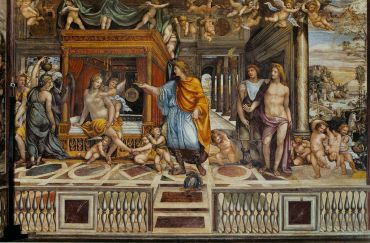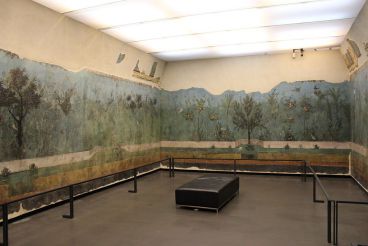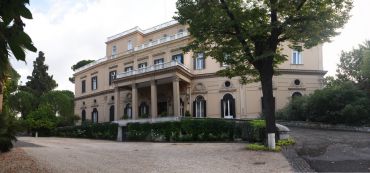Villa Farnesina, Rome

The Villa Farnesina is considered to be one of many mansions owned by Italian family Farnese along with others, such as Farnese Palace and the Villa Farnese. This is a quite fascinating Renaissance building that houses own gardens, its exterior works harmoniously with the magnificent interior. Currently, it functions as a museum that offers a glimpse of lifestyle once led by noblemen in the past. Art experts and simply aesthetes will enjoy frescos made by famous painters, specifically by Raphael.
Villa’s history
All started in May 1505. Back then a wealthy banker from Sienna named Agostino Chigi bought a piece of land in Rome and commissioned the construction. The first stone was laid on April 22, 1506, on Rome’s foundation anniversary. The architect from Sienna Baldassare Peruzzi was put in charge of the project, he was also a friend to the banker. The building along with loggias, galleries, and gardens called Viridario was finished by 1510, then in 1511, the owner moved in. In 1520, after Agostino Chigi’s death, the villa was left to decay, it was almost completely raided and ruined by writings made by mercenaries (hooligans existed even during the Renaissance epoch.) In 1557 the mansion was sold to powerful Cardinal Alessandro Farnese. He planned a great thing indeed – to connect the villa to his palace that was situated on the other side of the Tiber with a colossal bridge. However, this idea was never implemented. The residence belonged to Farnese for some time until Cardinal Odoardo Farnese’s grandson passed away.
After that many high-powered personalities took up their residence at the villa (Cardinal Richelieu; Christina, Queen of Sweden.) In the late 17th century the interiors were restored. Then in 1717, the place came into ownership of the House of Bourbon-Two Sicilies. Sometime later it was leased to an ambassador of Italy in Rome for 99 years. In the year 1927, the villa was bought by the government. Then in 1944, it became a place for housing the Accademia dei Lincei which was also accommodated by the Palazzo Corsini. In the late 20th century the building was restored once again.
Design of the Villa Farnesina
Villa’s design choices don’t exactly align with what you usually see in the Renaissance style. Its rectangular pavilion-shaped façade with a five-level loggia is somewhat pushed inwards, two parallel wings jut forward and consist of six stories. You can also notice the fountain in the front of the building and an Italian garden surrounding it. However, the most treasured thing here is the interior. Artists such as Baldassare Peruzzi, Sebastiano del Piombo, Raphael and his apprentices worked hard on it, Michelangelo also left his mark here.
Halls and loggias in the villa:
- The Loggia of Galatea. It owes its name to the fresco "The Triumph of Galatea" created by Raphael where an episode from Ovid’s "Metamorphoses" is depicted. To be exact, it is the one where sea-nymph escapes from mythical underwater creatures on a large shell. The walls here are decorated with frescos made by Peruzzi and del Piombo.
- The Loggia of Cupid and Psyche. It is adorned with frescos created by Raphael and his apprentices. It is an illustration of The Golden Ass by the author of antiquity Apuleius. There is also an inserted tale about marriage between divine and a human woman. The outer walls have a double row of Doric pilasters crowned with an entablature portraying cherubs and festoons. This loggia was used for carrying out various festive events.
- The Room of the Frieze. It is decorated with frescos made by Baldassare Peruzzi on which you can see 12 labors of Hercules and some other ancient myths. It was used as a waiting area for guests.
- The Hall of Perspectives. Painted by Peruzzi. The painter created an illusion of an open room and perspective view of Rome. Agostino Chigi celebrated his wedding and his child’s baptism.
- The wedding room. Initially, it was banker’s bedroom. The place is embellished with art made by Sodoma (Giovanni Antonio Bazzi.) Depictions of Alexander the Great and his wife Roxana’s wedding (namely, the wedding night) as well as commander’s fight and the taming of Bucephalus are here too.
Legends and facts
The villa has a few interesting stories to share, some of them were confirmed to be true by chroniclers. When Raphael was working on building's interiors, he met his love, 17 years old Margarita Luti, and offered her to be his art model. When the painter died, the girl was sent to a monastery. There is also another story to it: according to rumors, she made a fortune and became a famous courtesan in Rome.
Some say that Michelangelo left his mark on "The Triumph of Galatea." The legend has it, he once visited Raphael but didn’t find him at his workplace. Michelangelo then decided to leave a hidden message and painted a huge head of a man on the fresco. Raphael recognized friend’s style and let it stay on his artwork.
In the year of 1518 Chigi celebrated his child’s baptism. To show how rich he is, Agostino ordered his servants to throw all the golden and silver tableware in the Tiber after the next dishes were served. To be fair though, everyone was informed about this in advance so nets were placed under the water so that all these expensive things could be collected later.
How to get
The Villa Farnesina is situated on Tiber’s west bank, in the ancient region called Trastevere, near Vatican City and the Villa Doria Pamphili. Its address is Via della Lungara, 230. The most convenient way to reach this place is to take a bus 23, 280, or N11. Get off on the LGT Farnesina stop.
Opening hours: the villa is open daily, except for Sunday, from 09:00 till 14:00. You can also visit it on the second Sunday of the month from 09:00 till 17:00. There is another option available too – a visit on a different time can be arranged here, but it is only possible for a group that consists of more than 30 people. It will also cost more. Telephone: (+39) 06 68027397.
Admission: full ticket costs 6 euro, senior citizens and children between the ages of 14 and 18 can purchase a ticket for only 5 euros, kids between the ages of 10 and 14 can enter the villa for 3 euros. Children under the age of 10 are free of charge. Specially arranged visits will cost 360 euros. The villa offers guided tours inside the building and in gardens on Saturdays, but an extra 4 euros must be paid. The excursion for English speaking visitors starts at 10:00, for Italian – at 12:30. You can buy yourself an audioguide (available in English, Italian and French) for 3 euros. The information is relevant for 2018.




